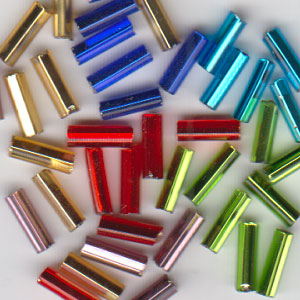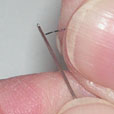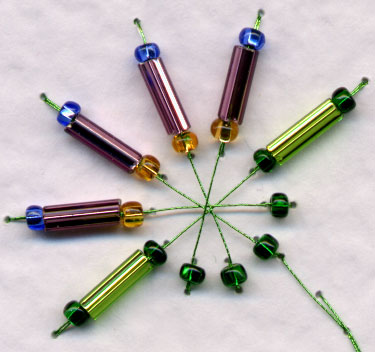The beads on the card samples shown on this web site are silver inside lined glass beads.
Feedback from customers who tried our bead patterns has shown that the patterns work well in a variety of types and colours of beads. However, this would require some experimentation on the part of the individual.
They may be available from your local craft shop or if not, an Internet search for ‘glass seed beads’ or ‘glass bugle beads’ should find a supplier, or see our Useful Links page.
Seed beads

Seed bead is a general term used for most small beads. They are usually round in shape and range in size from under one millimeter to several millimeters.
The Stitching Cards patterns are based on seed beads 2mm in diameter or 1/8 inch or aught size 10/0 (ten-aught). I have given the size several ways because various bead shops use different ways of expressing them.
The term aught refers to how many beads will fit in a standard unit. Originally aught size 10/0 meant there were 10 beads to an inch. With modern technology and machine cutting, there tends to be closer to 16 beads per inch.
Unfortunately, online bead shops do not always explain the relationship between the size numbers and aughts and millimeters. Also, Japanese beads tend to be a little larger than Czech beads of a given size number. If the beads are coated this can also add to the actual size of a bead.
There is enough room in the patterns to use slightly larger beads. However, if the seed beads are much larger then you could compensate by using shorter bugle beads. Since there are so many variables, my advice would be to buy just a few beads or a mixed pack to start with.
Bugle beads

Bugle Beads come in a variety of lengths but will always be longer than they are thick. This creates a bead with a tubular shape.
The Stitching Cards patterns are based on bugle beads 7mm long or 1/4 inch or Czech size number 3.
Japanese bead makers use a different numbering system to denote size: Size number 2 = 6mm. Size number 3 = 9mm.
Beading Needles
I use a size 10 English beading needle for small seed beads and bugle beads.

If you find the beading needle hard to thread then hold the thread tightly between your fingers, as close to the end as possible. Get it so that almost none of the thread will be showing between your fingers. Then with your other hand, move the eye of the needle on to the thread. It is much easier than using the traditional method of pushing the thread through the needle. Once you have the end of the thread through the eye you can pull it to the desired length.
When using a beading needle it is better to prick the pattern holes smaller than those made for normal embroidery needles. Otherwise the needle tends to fall through the hole and may come off the thread.
Fine needles are easily lost if you just lay them down. I use a small square of dark coloured material to stick the needles in. Then it is easy to find them again later.
Securing the beads to the card


Out at 1, through the beads and in at 2. Out at 1, through the beads and in at 3.

See our Useful Links page for equipment and materials suppliers.